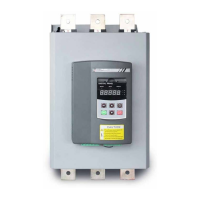29
Chapter 9 Fault causes and treatment
Fault codes and treatment as following table:
Problems and treatment methods
Just happened undervoltage, overvoltage or overheating,
instantaneous stop terminals are open, such failures, now has been
normal, this time to prepare lights, reset to start the motor.
External terminal
momentary
Open circuit
Short-circuit connection with the external Instantaneous stop
terminal⑦and public terminal⑩, or connecting to other protective
devices normally closed contact.
Start too often or the motor power do not match with the soft
starter.
Starting times too
longer than 60
seconds
Starting parameter settings is inadequate or the load is too heavy,
the power capacity is not enough, etc.
Check the input or main circuit failure, whether the bypass
contactor is stuck in the closed position and whether the SCR is in
open circuit and so on.
Check the input or main circuit failure, whether the bypass
contactor is stuck in the closed position and whether the SCR is in
open circuit and so on.
Check whther the input three-phase power supply and the load
motor is normal.
Whether the load is too heavy or motor power does not match with
soft starter.
Running overload
protection
Whether the load is too heavy or setting items P6, PP parameters
set incorrectly.
Supply voltage is
too low
Check the input voltage or setting item P7 parameter set
incorrectly.
Supply voltage is
too high
Check the input voltage or setting item P8 parameter set
incorrectly.
Modify the settings, or pressing the Enter key on power to restore
the factory values.
Check whether overloading or thyristor short circuit.
Automatic re-start
wiring error
Check whether the outside the control start and stop terminal is
connected to 2-wire mode.
External stop
terminal wiring
error
When you allow external control mode, the external control stop
terminal is in the open state, which can not start the motor.
Check the motor shaft and load faults.
Note: Some fault phenomena are interrelated, as the report Err02, may be related with soft
starter overheating or load short current, so when checking fails, consideration should be
comprehensive, accurately
determine
the point of failure.

